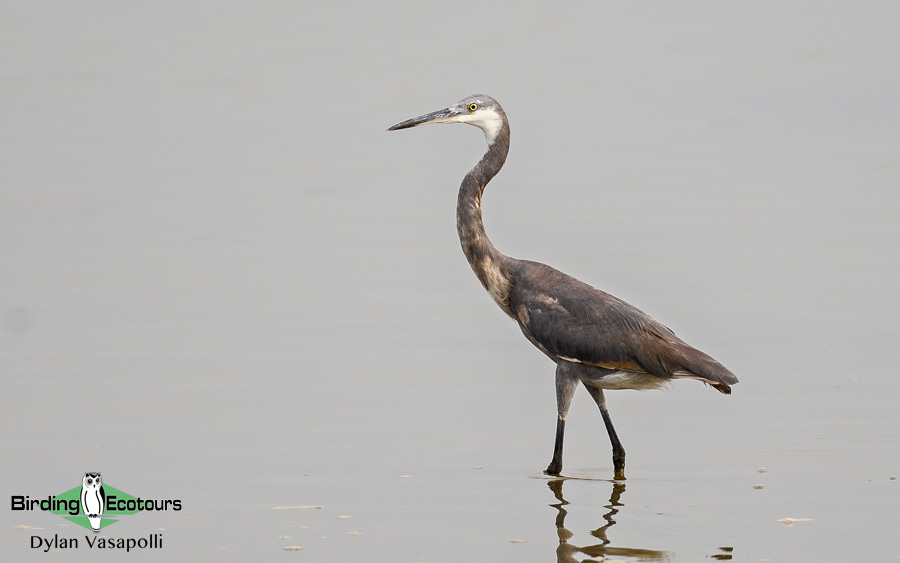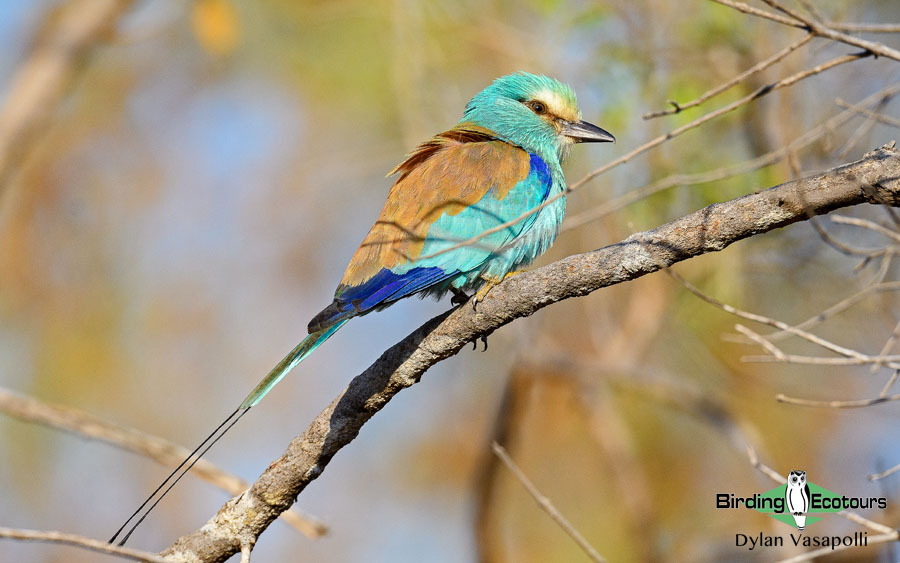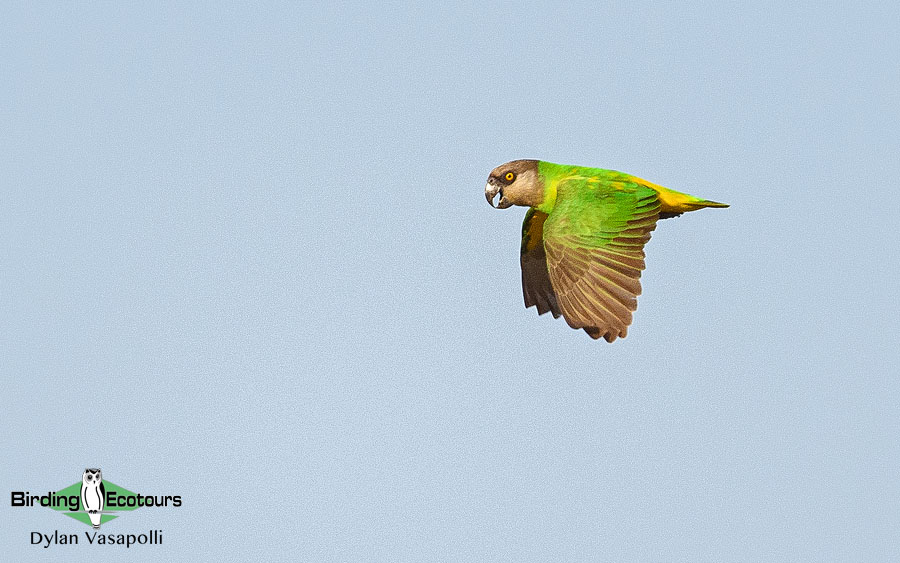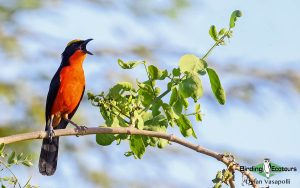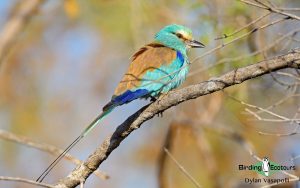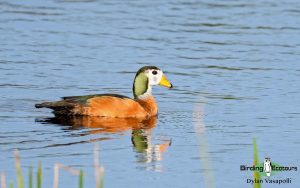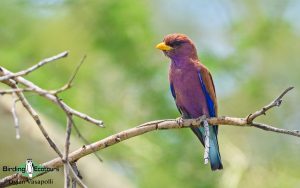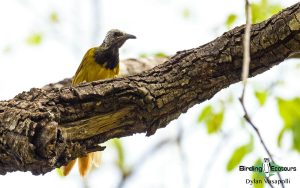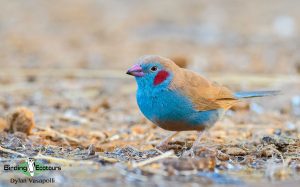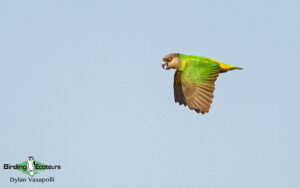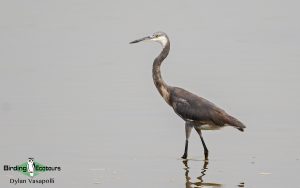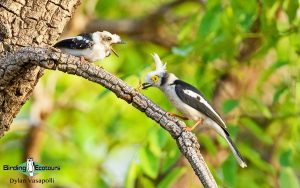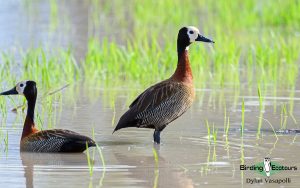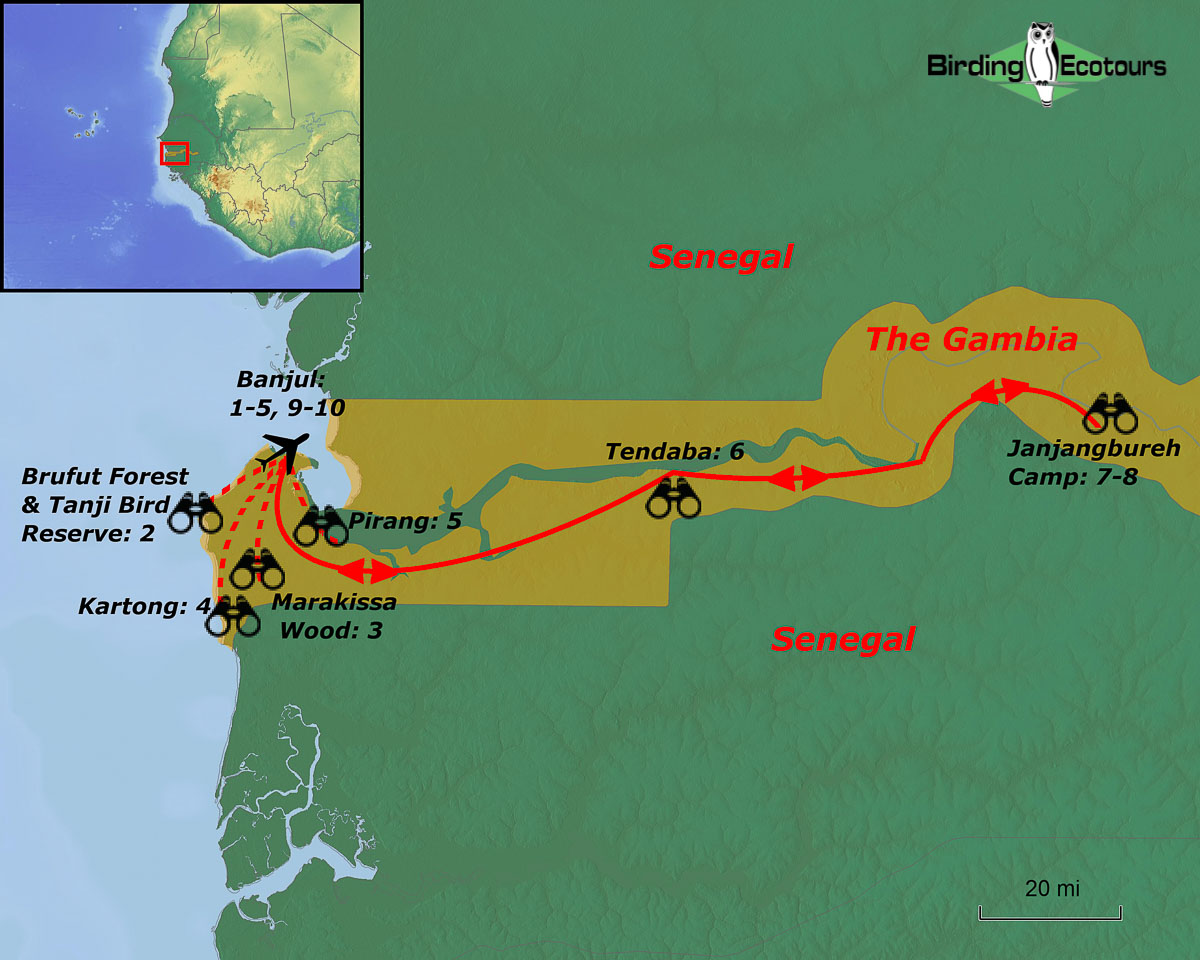Gambia: Winter Escape Birdwatching Holiday
Gambia: Winter Escape Birdwatching Holiday
January 2026/2027
Gambia, fondly known as the “Smiling Coast of Africa”, thanks to its tourist friendly reputation, is a well-known hotspot for birds and birders alike. None more so than for British and European citizens, with its quick and easy access, making bird-watching trips here very affordable and mightily enjoyable.
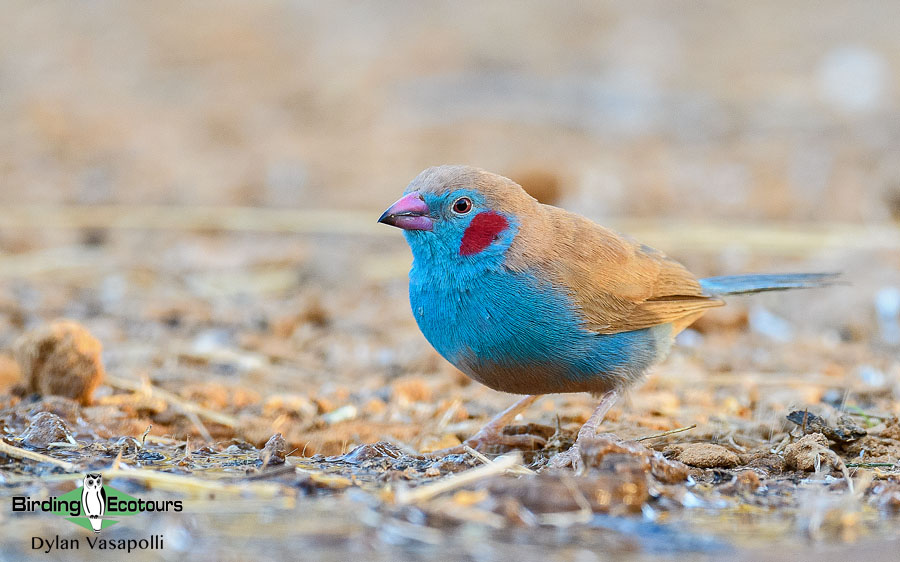
Indeed, this small country which is entirely surrounded by Senegal, offers action-packed birding – with an exciting mix of wooded habitats, forest patches and productive wetlands combining well. Additionally, Gambia can be covered thoroughly in just a few days and make trips here well worthwhile. This tour is timed specifically in the northern hemisphere’s winter period, to allow for a break from the cold and gloom of the UK and indeed Europe, all the while enjoying a prolific set of charismatic and distinctive African birds and families.
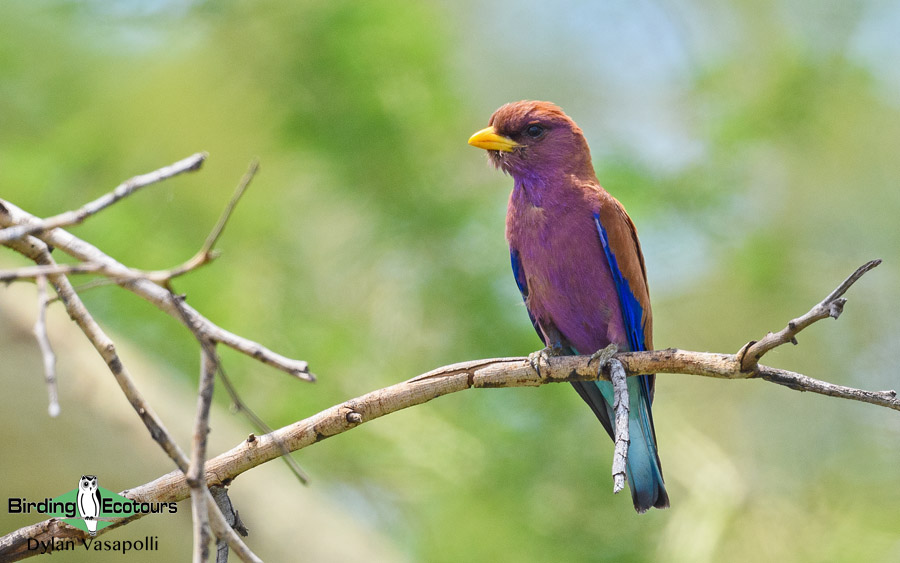
This comfortable tour is not particularly strenuous, and appeals to birders of all skills and levels of enthusiasm. Basing ourselves at the Senegambia Beach Hotel for the most part, we explore the surrounds for a wide spectrum of Gambia’s best birds, combined with a short foray inland to Tendaba Camp along the Gambia River for a few days in a different environment. For many, this is indeed their first taste of sub-Saharan African birds and families, with the likes of rollers, hornbills, turacos, robin-chats, sunbirds, and so many more, vying for attention.
Itinerary (9 days/8 nights)
Day 1. Arrival in Banjul
This tour begins with your arrival into the small Banjul International Airport in Gambia. This day is set aside as an arrival day, and you are welcome to fly in at your leisure. There are no formal plans for the day, but for those arriving earlier in the day (or the day prior), the grounds of our hotel offer a superb introduction to some of the common and widespread species found in the country. Bold and conspicuous birds like Western Plantain-eater, Western Red-billed Hornbill, Broad-billed Roller, Yellow-crowned Gonolek, Long-tailed Glossy Starling and Snowy-crowned Robin-Chat are all regular, while the regular feeding of the large numbers of Hooded Vultures add to the spectacle.
Overnight: Senegambia Beach Hotel
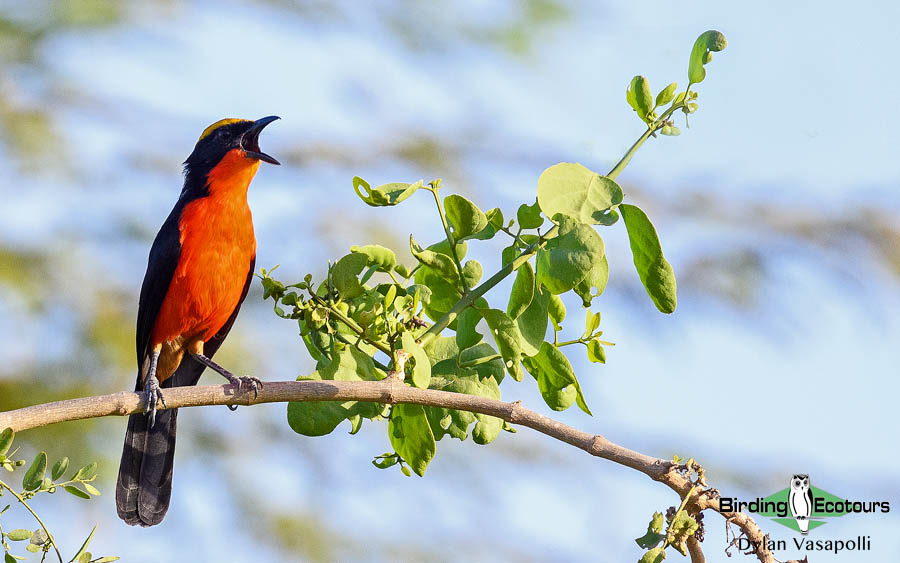
Days 2 – 5. Birding day trips to forests, woodlands and wetlands around coastal Gambia
Basing ourselves at our comfortable hotel, we have four full days available to explore the bird-rich surroundings. We will undertake a mix of full day trips out from the hotel, and dedicated morning and afternoon excursions with a midday break in between. We anticipate visiting a wide range of well-known local sites, including Brufut woods, Pirang wetlands, Farasutu forest, Kartong Bird Sanctuary and Tanji Bird Reserve, amongst others.
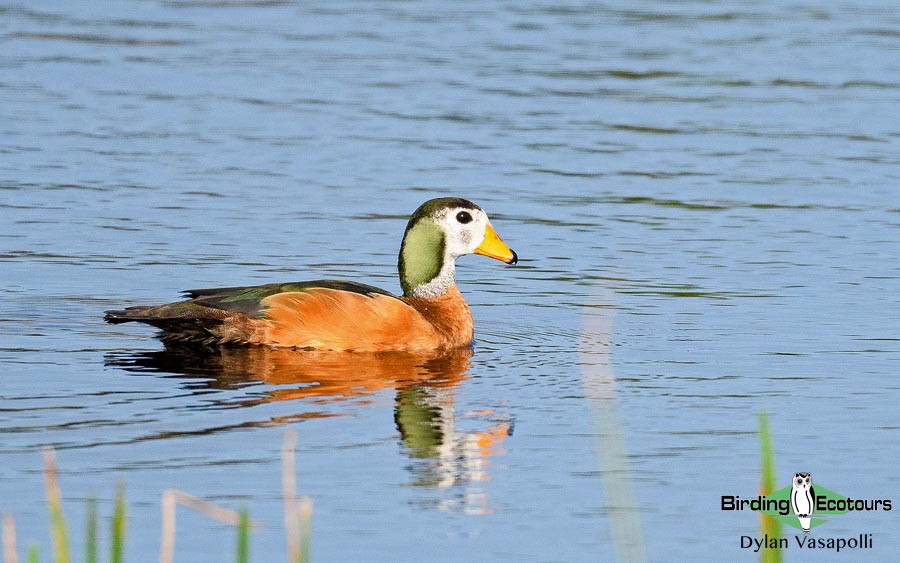
As we go about all our travels and explorations, wetland habitat will be a regular feature and on top of the common and numerous birds like White-faced Whistling Duck, Spur-winged Goose, African Darter, Great Egret, Squacco Heron, Hamerkop, Spur-winged Lapwing and Pied Kingfisher, we will also look for more local and scarce specials. These may include species such as African Pygmy Goose, Goliath, Western Reef and Black Herons, African Woolly-necked Stork, Pink-backed Pelican, Greater Painted-snipe, Senegal Thick-knee and Giant Kingfisher amongst others. Coastal areas usually hold a variety of terns and shorebirds, and we’ll keep a special lookout for birds like West African Crested Tern, alongside more widespread species, including Common, Caspian and Sandwich Terns, Grey-headed and Lesser Black-backed Gulls, and many shorebirds overwintering from the northern hemisphere – such as Eurasian Whimbrel, Common and Little Ringed Plover, Bar-tailed and Black-tailed Godwits, Common Greenshank, Ruddy Turnstone, Sanderling, Ruff, and various sandpipers.
Western Reef Heron occurs around the coastal parts of the country.
Forested areas and patches of denser woodlands and thickets hold an exciting range of birds. Both the spectacular Violet and Guinea Turacos and the bizarre Oriole Warbler will feature highly on our wishlist, along with others like Spotted Honeyguide, Buff-spotted Woodpecker, Brown-throated Wattle-eye, Red-bellied Paradise-Flycatcher, Blackcap Babbler, White-crowned and Snowy-crowned Robin-Chats, Olive-naped Weaver, delightful Lavender Waxbills and, if we’re lucky, the scarce Western Bluebill.
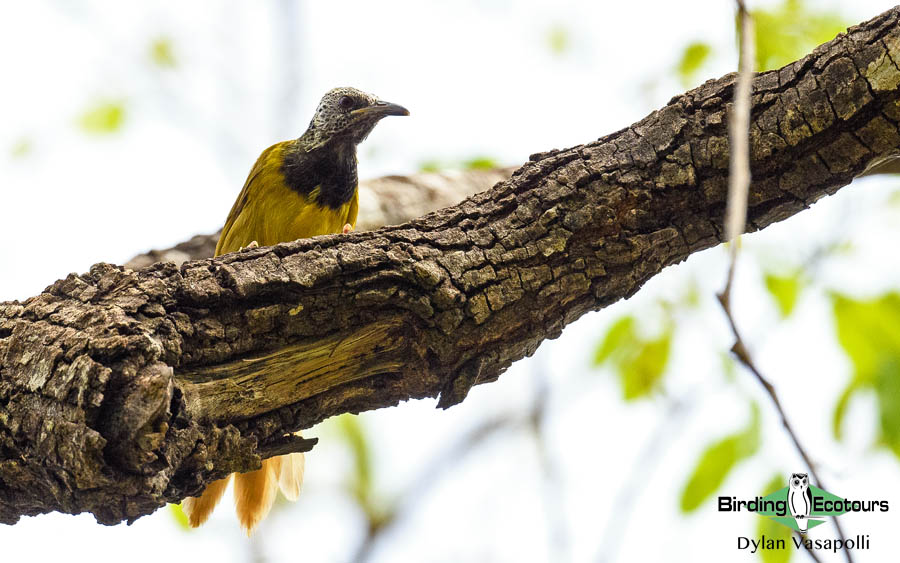
Many sites also incorporate more open woodland habitat, and even though this can be fairly degraded in places, these areas are always incredibly birdy. Many of the common birds around our hotel grounds are a regular feature like Western Plaintain-eater and Western Red-billed Hornbill, but we will also look carefully for many others as well. Noisy Double-spurred Spurfowl run along the open tracks, while comical Green Wood Hoopoes cackle about, and stately Bruce’s Green Pigeons perch atop the dead trees. Sought-after birds like Blue-bellied and Abyssinian Rollers often perch along the wires and are occasionally joined by the dainty Little Bee-eater. While Bearded Barbets and Yellow-fronted Tinkerbirds are invariably heard before being seen, we will also carefully listen out for the soft calls of Fine-spotted Woodpecker, while noisy Senegal Parrots commute about regularly. Various starlings often provide a hit of color, with the likes of Lesser Blue-eared, Purple and Long-tailed Glossy Starling routinely seen, while spectacular sunbirds like Scarlet-chested and Beautiful Sunbirds are never far away. These are only a small number of the many species we’re likely to see, and should be enough to whet your appetite for our birding over these first days.
Overnight: Senegambia Beach Hotel
Abyssinian Roller is one of the many woodland specials that we’ll see.
Noisy Senegal Parrots commute up and down throughout the day in parts of the country.
Days 6 – 7. Birding Tendaba Camp – inland Gambia
We temporarily say goodbye to the Senegambia, as we transfer inland to the more basic Tendaba Camp, located on the Gambia River, for two nights.
We will bird along the way to Tendaba, with stops that might include birds like Leaf-love and Oriole Warbler (if we’re still missing this special bird), along with scarcer wetland birds like African Pygmy Goose. As we head farther inland, raptors become a bit more regular and many species are possible. We’ll keep an eye out for the scarcer species like Brown Snake and Western Banded Snake Eagle, Martial Eagle, African Hawk Eagle, Dark Chanting Goshawk and even Grasshopper Buzzard as well.
Once we reach Tendaba Camp, the bulk of our time will be spent birding the dry woodlands in the surrounding area, which support several sought-after and scarce species. Birds such as Vieillot’s Barbet, Black Scimitarbill, Brown-backed Woodpecker, White-shouldered Black Tit, White-crested Helmetshrike, Senegal Eremomela, Bronze-tailed Starling, Pygmy Sunbird and Brown-rumped Bunting will feature as big targets. We should also be able to find more widespread species like Striped and Woodland Kingfishers, Brubru, Red-cheeked Cordon-bleu, Yellow-fronted Canary and Cut-throat Finch, amongst many others. If we’re fortunate, we may run into the prehistoric-looking Abyssinian Ground Hornbill striding through the area. A convenient photo hide attracts many species, and usually provides excellent views of the various starlings and small seedeaters (like the bright cordon-blues, waxbills and canaries).
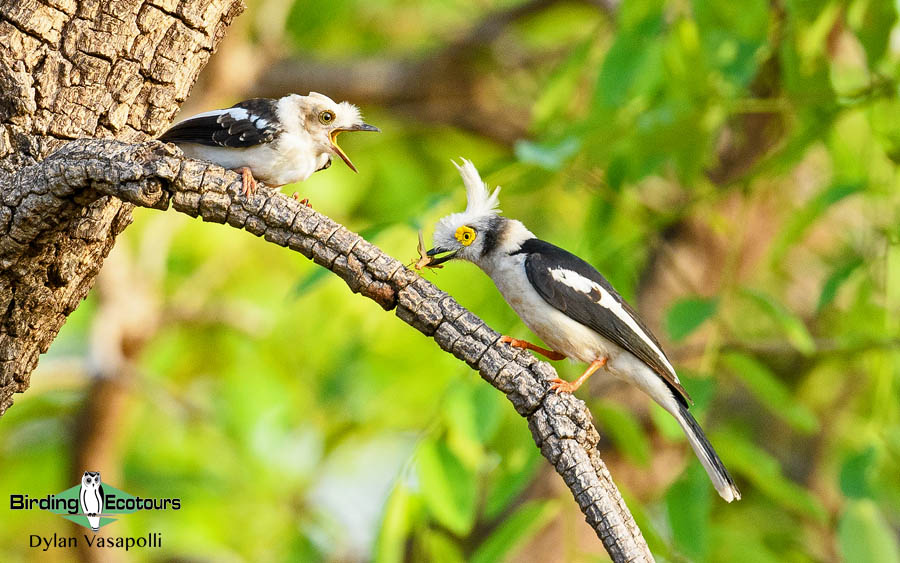
We will also undertake a boat trip on the Gambia River here and, while we should have seen most of the possible waterbirds already, this is always an enjoyable outing on any tour! Various waterbirds, including cormorants and a wide array of egrets and herons, commute up and down along the river, and roving Pink-backed Pelicans are often about, along with the ubiquitous Pied Kingfishers. The majestic African Fish Eagle is usually seen as well.
Overnight: Tendaba Camp
Day 8. Birding back to Banjul
We have a final morning available for birding the Tendaba region, before we’ll need to navigate our way back to Banjul. We will keep the morning flexible, and use it to try and track down any notable species we might not have found yet. We will return back to our familiar Senegambia Beach Hotel in the afternoon, as we wind up the tour and reminisce about the exciting birds we will have enjoyed.
Overnight: Senegambia Beach Hotel
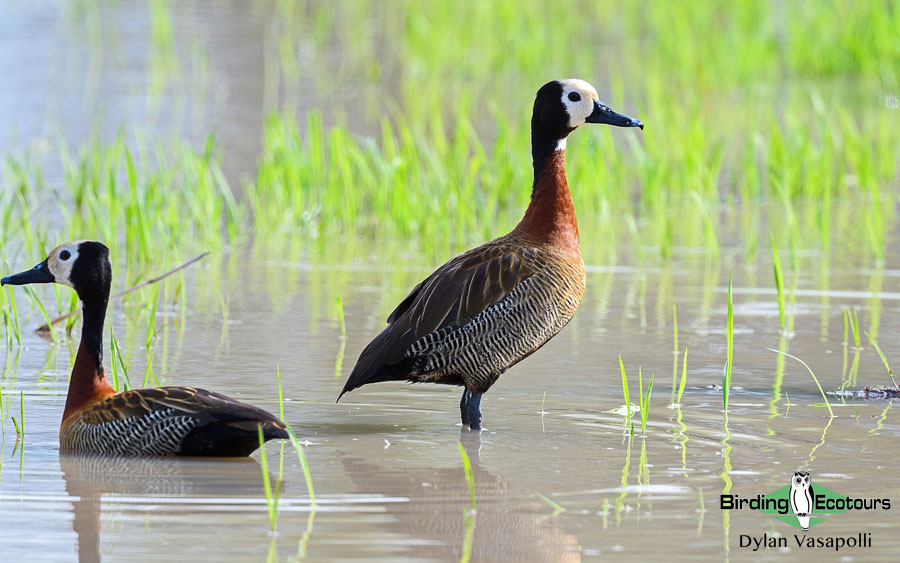
Day 9. Departure from Banjul, Gambia
This day is set aside for your departure from Banjul, and no birding plans are included. You can depart at your leisure.
Please note that the itinerary cannot be guaranteed as it is only a rough guide and can be changed (usually slightly) due to factors such as availability of accommodation, updated information on the state of accommodation, roads, or birding sites, the discretion of the guides, and other factors. In addition, we sometimes have to use a different guide from the one advertised due to tour scheduling or other factors.
Download ItineraryDuring our small group tour, you will be driven by your guide in a comfortable vehicle. This tour does involve some longer walks but these will be on flat, firm ground, except for some sites where the ground may be sandy.
Throughout the coastal part of our tour, we will stay in the wonderful Senegambia Beach Hotel. This hotel is as good as hotels get, even by Western standards and features every facility you could want. The grounds of this hotel have also recorded over 200 bird species so serve as a great way to get to grips with the more common African species. They also feed the resident Hooded Vultures at 2pm every day which makes for a great spectacle (of what is now a Critically Endangered species).
Temperatures during our tour will be hot to very hot. In coastal areas, day temperatures are typically 86 – 95F (30 – 35C), falling, eventually, to around 70F (21C) at night. Humidity is generally low unless we encounter an overcast day where the temperature will be lower but significantly more humid. Our visit to upriver areas will see the temperatures climb further where we can expect 95 – 104F (36 – 40C), falling, eventually, to around 75F (24C) at night.
